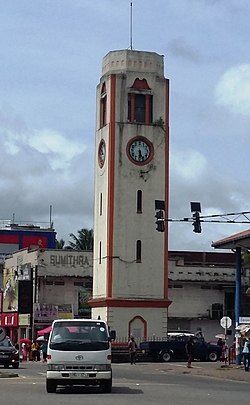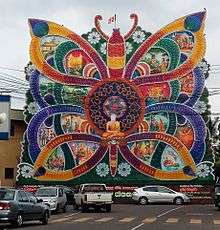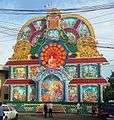Piliyandala
Piliyandala (Sinhala: පිළියන්දල, Tamil: பிலியந்தலை) is a suburb in Colombo, Sri Lanka. It is situated approximately 18 kilometres (11 mi) south of Colombo. It is one of the relatively more populated suburbs located in the Colombo District of the Western Province, Sri Lanka and it is surrounded by the suburbs of Moratuwa, Kesbawa, Maharagama, Pannipitiya, Bandaragama and Kahathuduwa. Piliyandala has a thriving market in the town centre (next to the clock tower) and the Kesbewa Urban Council is also located in Piliyandala.
Piliyandala පිළියන්දල பிலியந்தலை | |
|---|---|
suburb | |
 Piliyandala | |
| Coordinates: 6°51′0″N 79°57′0″E | |
| Country | Sri Lanka |
| Province | Western Province |
| District | Colombo District |
| Time zone | UTC+5:30 (Sri Lanka Standard Time Zone) |
| • Summer (DST) | UTC+6 |
| Postal Code | 10300 |
Etymology
It is said that prince Sapumal after capturing Yapa-Patuna (modern day Jaffna) in the 15th century AD, changed his attire in the area of Piliyandala before meeting the king in the Kotte kingdom. Thus, the name Piliyandala is derived from the words 'Pili+Andi+Dola' (පිළි+ඇඳි+දොල), meaning the stream where the king had a bath and changed clothes. This stream is still running through Piliyandala, but its now reduced to a little stream. [1]
Piliyandala clock tower
According to local residents and documentation, Piliyandala clock tower is one of the tallest in the island rising to a height of 78 feet with a 16-foot girth. The clock tower was erected by D. Simon Samarakoon, in the memory of his parents Cornelis Wijewickrema Samarakoon and his wife. The foundation stone for the erection of the clock tower was laid by the then Minister of Local Government C.W.W. Kannangara on 11 September 1952. The construction being completed in seven months, the clock tower was commissioned on 30 April 1953 and has been running ever since.
The clock tower in existence for more than 60 years is considered to be of archaeological value thus providing the Piliyandala town with a historical background.[2]

Education
Piliyandala Central College, the first national sports school established in Sri Lanka is situated in this suburb. It is one of the first central colleges founded by Hon. C. W. W. Kannangara and has about 5,000 students. The school provides facilities for sports such as Rugby, Carrom, Cricket, Football, Girls' Football, Chess, Wushu, Badminton, Karate, Swimming, Athletics, Basketball, Volleyball and Netball. Other popular schools in the area include;[3]
| Primary Schools | Secondary Schools | Private Schools (International) |
|---|---|---|
| Piliyandala No: 1 Kanishta Vidyalaya | Mampe Dharmaraja Maha Vidyalaya | Negombo South International School |
| Somaweera Chandrasiri Vidyalaya | Sir John Kotelawela Maha Vidyalaya | Guidance International School |
| Mampe Junior School | Madapaatha Philip Artygalle Maha Vidyalaya | Leeds International School |
| Deltara Kanishta Vidyalaya | Kesbewa Dharmasena Attygalle Balika Vidyalaya | Linfield International School |
| Makuluduwa Kanishta Vidyalaya | Wewala Ananda Samarakoon Vidyalaya | |
| Makuluduwa Kanishta Vidyalaya | ||
| Hedigama Sri Sudarshana Kanishta Vidyalaya |
Beyond the schools in the region, Piliyandala remains only a mere 3.5 kilometers away from the University of Moratuwa, The most prestigious Engineering university in the country.
Piliyandala have gifted Sri Lanka many notable people such as, Sri Jhon Kothalawala, MP Somaweera Chandrasiri, cricketer Hashan Thilakarathna, singer Kalhari.
Demographics
Piliyandala is a Sinhala majority area; there are minor communities belonging to other ethnic groups, such as the Moors and Tamils.
Religion
Piliyandala has a number of Buddhist religious places which follow the teachings of the Theravada school, including:
- Sri Bimbaramaya, Kolamunna
- Sri Sudarshanaramaya, Hedigama
- Sri Jayabodhi Viharaya, Piliyandala
Piliyandala also has a number of churches, including:
- St. Luke's Church, Mampe, Piliyandala
- Our Lady of Lourdes Church, Dampe, Piliyandala
Piliyandala Vesak Thorana
The narration of Jātaka tales has been developed into Thoran tradition which is unique to Sri Lankan Buddhist culture. Continuing this iconic tradition, in Vesak season of Sri Lanka, an electrically lit pandol which is famous as Piliyandala Thorana is erected in front of the Piliyandala Central College. In these pandols, each scene of a selected Jataka tale will be boarded with different colored lights which created attractive patterns and sequence of different lighting patterns was electronically programmed.
 2015
2015 2016
2016 2017
2017
Piliyandala Thorana is usually accompanied by singing or reciting the story in verses and they are in the special form of poetry reciting or singing which is known as “viridu”; and certain thorana is accompanied by dialog in addition to the reciting. Piliyandala Thorana is sponsored by local donors, religious societies and mainly organized by Vaishakya Pujothsava Kamituwa of Piliyandala.
Infrastructure
Health
Divisional Hospital - Piliyandala (which was established as a Maternity Home in 1939) is a type - B divisional hospital belongs to Ministry of Health and Indigenous Medicine, Sri Lanka. Currently the hospital offers dental clinic, family health clinic, medical clinic, mental health clinic, ante natal clinic, baby clinic, well women clinic, family planning clinics, skin clinic, Direct Observation Treatment (DOT) for TB unit and laboratory services..[4]
Transportation
Two major roads run through of Piliyandala. The road connecting Colombo and Horana, known as the 120 bus route and the road connecting Mount Lavinia and Kottawa (the 255 bus route). In addition, a new bypass road named Piliyandala Bypass Road was built in 2015 connecting Piliyandala and Kesbewa Junction. The beaches of Mount Lavinia are a 15-30 minute drive away from Piliyandala. There are other bus routes from Maharagama to Piliyandala, Bandaragama to Pilyandala(the 162 bus route). The Kahatuduwa Interchange, which is located between Polgasowita and Gonapola towns on Colombo - Horana (120) Road, connects the Piliyandala to the Southern Expressway.
Bus Routes travelling via Piliyandala
- 120 - Pettah - Piliyandala - Kesbewa / Horana
- 162 - Pettah - Bandaragama
- 255 - [[Dehiwala-Mount Lavinia|Mt Lavinia]] - Kottawa (via Piliyandala)
- 17/255 - Panadura - Kandy
- 425/2 - Maharagama - Matara / Dickwella
Bus Routes terminating at Piliyandala
- 127 - Moragahahena
- 139 - Kohuwala
- 139/1 - Kalubowila
- 149 - Diyagama / Homagama
- 149 - Bandaragama (via Diyakada)
- 157 - Kahapola
- 157/1 - Makandana (Via Batakettara)
- 157/2 -Gadabuwana
- 158 - Moratuwa
- 159 - Palagama
- 162 - Bandaragama
- 162/1 - Ambalangoda Polgasovita (western)
- 295 - Dampe
- 296 - Kottawa (via Polgasovita)
- 341 - Maharagama
- 342 - Kottawa (Polgasovita)
References
- "PILIYANDALA – FROM 15TH CENTURY TRANSIT POINT TO COLOMBO'S MAIN TRANSPORT HUB". LankaPropertyWeb.com. Retrieved 15 December 2017.
- "Homage to 50 years old clock tower". Daily News. Retrieved 5 July 2014.
- "School Information". Piliyandala Education Zone. Archived from the original on 7 August 2013. Retrieved 5 July 2014.
- "Divisional Hospital - Piliyandala". Ministry of Health and Indigenous Medicine, Sri Lanka. Retrieved 31 July 2015.